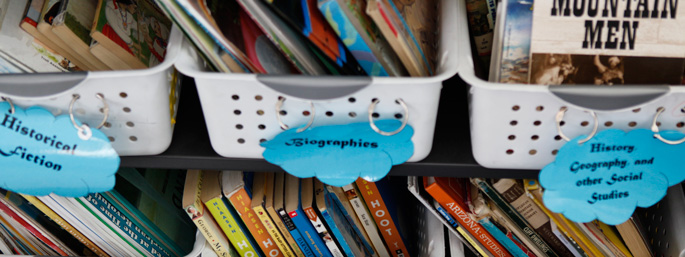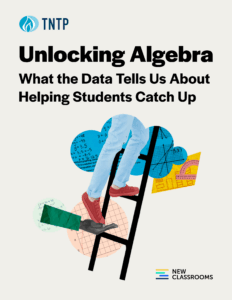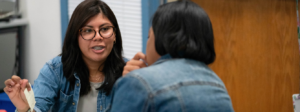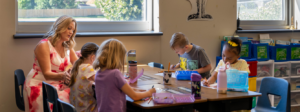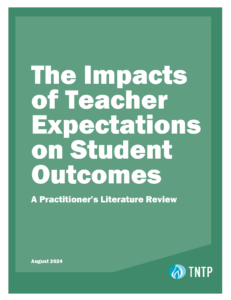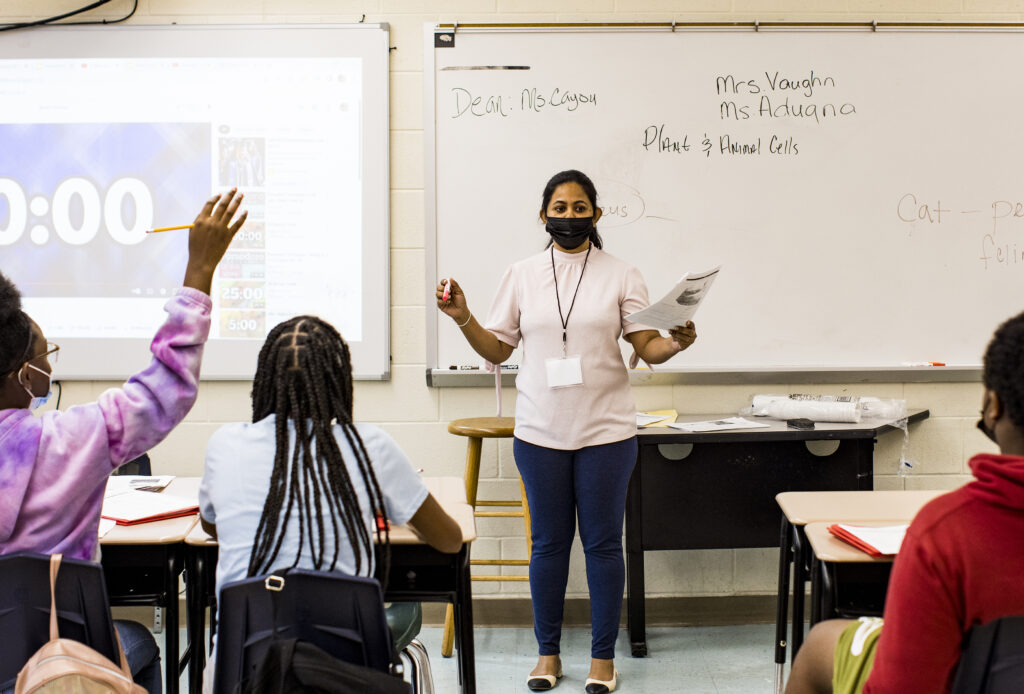If you want to know whether students are getting what they need from a school, find out what they’re working on each day. Consistent access to challenging, engaging assignments is crucial to preparing students for success in college and beyond—and can help students who’ve fallen behind academically catch back up. But too many students spend hundreds of hours each year on assignments that are below their grade level and irrelevant to their lives. Most of these students fall short of college- and career-ready standards—not because they can’t meet them, but because they haven’t been given a real chance to try.
Over the last several years, a small group of districts in Tennessee, the LIFT network, has worked to close this “opportunity gap” in an especially critical subject: early-grade literacy. With support from TNTP and Tennessee SCORE, these districts have adopted standards-aligned literacy curricula—and provided teachers with the resources and support they need to bring them to life for every student.
We recently sat down with a principal in one of those districts. Don Maloney is now entering his eighth year as principal of Lenoir City Elementary School, located about 30 miles southwest of Knoxville. The school serves about 550 students, many of whom speak English as a second language. Don reflected on his school’s experience adopting the EL Education Language Arts Curriculum. While it wasn’t easy, the shift is already paying off for students: the percentage of students at the school scoring “on track” or “mastered” on Tennessee’s ELA exam nearly doubled last year, from 17.5% to 31.8%, and the state designated Lenoir City Elementary a “Reward School” for its strong academic achievement and growth among all students and demographic groups.
How did you know something had to change about literacy instruction in your school?
Well, this is my 17th year at this school, and my 8th year as principal. Language arts has always been an Achilles heel for us. Two years ago, before we joined LIFT, we’d tried almost every language arts curriculum you could think of, but they just weren’t giving us what we needed. Our students’ reading comprehension, in particular, wasn’t there. It wasn’t for lack of trying: our teachers were doing the best they could and were coming to the table prepared. But we were still seeing only about 20 percent of our third graders on track to meeting grade level standards in language arts. That’s just unacceptable. How can you look at a group of kids and say, “8 out of 10 of you are going to fourth grade already behind in reading”? I finally decided I was tired of talking about it. We needed to take a stand and make some headway.
Is that what brought you to LIFT?
Absolutely. In November 2017, we got a call from LIFT letting us know there was an opportunity to join the network, and we jumped on it. And in January 2018, we were able to pilot the EL Education Language Arts curriculum for the first time. With support from LIFT and TNTP, we piloted two modules in second and third grade that spring, and then we worked to roll out the full curriculum across grades K-3 for the 2018-19 school year. So, we had a major shift in curriculum, and at the same time began a change in culture and vision for what English Language Arts instruction needed to be at our school. We wanted to focus on teaching literacy skills in integration instead of in isolation, which is what the research has been telling us kids need. And we wanted more continuity from grade level to grade level. The EL curriculum has supported that. Even in the short time we’ve used it, I’ve seen kids seeing pieces of the curriculum and saying, “Oh yeah, that’s what we did last year.”
What other results have you seen from the shift to the new curriculum?
We’re seeing much better vocabulary out of the students. We're seeing better writing samples. Just today, I was in a second-grade classroom and the teacher said, “Look at this writing.” This is day two, and the kids are writing in complete sentences. It looked like something that you would see toward the end of the school year in the past. And we just got our test scores from last year showing that we nearly doubled the percentage of our students who’d mastered or were on track to master grade-level standards in literacy.
Our students’ enthusiasm for learning has improved, too, which is just as important. Their curiosity has improved. They’re proud of themselves. We have celebrations of learning that take place at the end of the modules, and we have had standing room only for them because kids go home and tell their parents, “We're going to do our celebration of learning next week, and I want you to be there to see what I'm doing.” One celebration at 9:00 AM had more than 125 second-grade parents attend. They took off work and stayed for more than an hour and watched their children talk about dinosaurs, pollinators, frogs and all kinds of great things. Three years ago, I’m not sure I would have had 20 parents attend events like that. It’s been fantastic.
What changed for your teachers with the new curriculum?
In the past, teachers were having to spend hours and hours just trying to come up with what to teach. They didn’t have a whole lot left in the tank to do the things that helped them understand where their kids were: to scaffold instruction, to differentiate, and all those important things. With the EL curriculum, the texts are there. The challenging questions and writing tasks and other elements are there. The skills block lessons are there. So instead of spending time finding materials or creating lessons from scratch, they can think about how to adapt some really strong resources and make them their own, how to really give students ownership during the lesson, and how to support students who might struggle.
How did you support teachers in making the transition?
If you just hand a group of teachers a curriculum, especially one that's as detailed and as deep as this one, you can’t expect to get very good results. We invested a lot of time in professional development to get our teachers up to speed on EL, because we knew we needed to hit the ground running. And LIFT helped us provide a lot of support throughout the year. We did classroom walkthroughs, and based on what we saw, we created professional learning community sessions. I also added a language arts coach to our staff to support teachers. Overall, our professional development has become a lot more focused on the curriculum itself. It sends kids deep into subject areas, so we’ve gone deep with the strategies teachers need to support that work. And these are all things we’re doing in response to what we’re actually seeing in classrooms.
I think it’s paying off. When we introduced the new curriculum, some of our teachers struggled, because this is a tough curriculum. It’s a whole new way of looking at how you teach students to read. As the year progressed, I think they started to believe in it, but now with our latest test scores, they have something to grasp hold of and say, “We can do this. Our kids can do this.” Their confidence has improved and when the teachers' confidence improves, the students' confidence improves—and we just keep cycling that through.
What are you excited about as you look ahead to the third year with this curriculum?
Our school year is off to a strong start and it's only going to get better. We have about a 20-acre patch of woods right beside the school and back in the spring, one of our teachers went out there and suggested we create an outdoor classroom, since the EL modules lend themselves so much to the outdoors. Since then, we've created a butterfly garden, and we are going to collaborate with the middle school and the high school carpentry classes to repair the seating and gazebo stage out there. We’ve really started to bring this curriculum to life.
On a personal note, I’ve toyed with the idea of retiring. This is my 45th year in education. But this curriculum and our work as part of LIFT has been really energizing. I want to see last year’s kindergarten students take the TN Ready test when they’re in third grade, so that I can be here to see that this is the success I feel certain now it’s going to turn out to be. I want to see this through.
What advice would you give to other administrators looking to adopt a curriculum like EL?
Get in the weeds with your teachers and provide ongoing professional development. I’ve heard stories of teachers receiving a curriculum two weeks before school let out for the summer and being told, “good luck.” I don't care what curriculum you're dealing with—you cannot put teachers on a limb and then saw the limb off behind them.
When you're doing a shift this detailed and deep, you better be prepared to offer the support teachers need. Give them an opportunity to learn it. Give them an opportunity to grapple with it. Become one of them, especially if you're like me and don't have an early literacy background. As the instructional leader in the building, if I can't go into a classroom and be able to understand what I'm seeing and be able to provide feedback, then I'm not doing myself any good and I'm certainly not doing the teachers any good.
And even if you do have the background, you still need to be in there with them so that they see that you’re all in this together. Let them know you’re going to struggle together, learn together and celebrate together when you start to see results.
